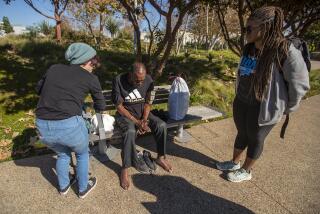City’s All-Out Battle Cleans Up the Streets : Hookers Are Gone, but Stanton Worries That They May Call Again
- Share via
First, the curbs were painted red, making it illegal to stop, stand or park along the street.
But Stanton city officials soon learned it would take more than paint to wrest control of Beach Boulevard from an army of prostitutes who had occupied it.
It took a seven-month battle that included an ordinance making it tougher for hookers to conduct business, increased police and prosecution efforts and a placard-waving mayor leading his own battalions of outraged citizens.
Last week, Stanton declared a victory even as the enemy was conceding defeat.
“I’m headed back to Texas,” said 25-year-old Toni--dressed in tight-fitting jeans, fringed cowgirl boots and a matching leather jacket--after spending a few nights on the boulevard. “I can’t make any money here.”
“Our problem has gone away,” said City Manager James Buell, adding that it had been one of the toughest fights in the city’s 30-year history.
Officials agree, however, that Stanton’s victory is likely to be some other city’s loss.
“It’s like clay you mold in your hands,” Stanton Police Chief Robert Eason said. “It doesn’t disappear--it squeezes out someplace else.”
That, indeed, has been the history of prostitution in Orange County, at least since the late 1970s.
It was in 1977 that Anaheim police began a crackdown after hookers converged on Harbor Boulevard, competing with nearby Disneyland for the tourist business. Anaheim’s anti-hooker efforts pushed the problem south on Harbor into Santa Ana, which in turn diverted it into Garden Grove and Buena Park.
By 1981, Stanton had its first significant influx of prostitutes, according to Eason, though it wasn’t nearly as serious as the invasion last fall. Stanton police had been able then to step up anti-prostitution activities and drive them back into Garden Grove and Buena Park.
Within three years, they had returned to Anaheim, and another anti-hooker campaign, this one tied to the 1984 Olympics, prompted the same migration cycle.
But Stanton officials say the proportions of the most recent invasion of their city were unprecedented.
The problem demanded a high-profile solution, said Eason, who admitted that the city’s 35-person police force simply could not stem the tide alone. Fifty to 60 prostitutes a night were common along a 3 1/2-mile-stretch of Beach Boulevard within Stanton’s boundaries. In one month police reported 554 prostitution arrests.
Lacking funds, Stanton police converted a borrowed police Explorer Scout van used for camp outings into a makeshift paddy wagon. They barricaded Beach Boulevard’s curbside lane with traffic cones and stepped up police patrols, stopping suspected prostitutes for even the smallest littering infractions to get them off the street.
They called on the Sheriff’s Department for assistance, and the response included undercover officers and other assistance, said Sheriff’s Capt. Tim Simon, who is in charge of the special investigations division, which includes vice. That assistance is continuing.
The City Council passed an ordinance making it illegal for a person to rent the same motel room more than once in any 48-hour period.
At night, citizen patrols roamed the boulevard to make it more difficult for prostitutes to pick up customers discreetly. And Mayor Sal Sapien, armed with a placard, earned recognition with his publicized walk against prostitution.
At the same time, local prosecutors began pushing for jail time and stiff fines for first-time prostitution offenders. And they sought the same punishment for the prostitutes’ customers, known on the street as “Johns.”
Fines for the Johns
“Now we’re asking the judges to impose the same jail time, 10 days and a fine on the Johns--the same as we propose on the prostitutes,” said Deputy Dist. Atty. Jan Nolan, who is in charge of the district attorney’s office in Westminster. Her office handles prosecutions of suspected prostitutes arrested in Stanton.
When Nolan was invited to tour Beach Boulevard on a busy night last fall, “it was quite an awakening,” she admitted. She, in turn, recommended similar tours for others in her office.
“I thought it was important for them to see what was going on,” Nolan said. “They were very surprised at the situation out there.”
Some Stanton business owners say city and law enforcement officials waited too long to mount their offensive.
Robert Red, who has owned a Stanton pizza restaurant for 15 years, said he was irritated by prostitutes who annoyed his customers, but also was frustrated with police and city officials who let the problem develop.
“What turned the tide,” Red said, “was a number of frustrated residents who got out there and put pressure on the city and the police chief. People were sitting on their hands too long.
Bad for Some Businesses
“The whole prostitution thing hurt business really bad. It got to the point where customers wouldn’t want to bring their wives down here because strange men would think they were prostitutes.”
Red and other business owners remain fearful that the problem “won’t go away for good.” They suspect that the relative calm of last week will dissipate all too soon.
There is evidence that the problem hasn’t traveled far. Already, police in adjacent cities report that some of Stanton’s hookers are being spotted in new locales.
But they are hesitant to say exactly where, and more than one police administrator said he did not want to be interviewed on the subject because of fears that their comments would draw attention and might result in more hookers in their jurisdictions.
Priscilla Alexander, co-director of COYOTE, a prostitutes’ rights organization based in San Francisco, scoffs at Stanton’s pronouncement of success. In a phone interview last week, she described the city’s effort as “stupid and pointless.”
“What they’ve had in Stanton is a classic reaction,” Alexander said. “When they realize what they’re doing is stupid and pointless, then maybe they’ll wake up. Prostitution is not going away.
Stanton’s Image
“They should get their Legislature to decriminalize prostitution. They seem to have tried every punitive measure, and all it does is make it worse. If prostitutes can earn more money doing something else, then they would change.”
To business owners in Stanton, however, that’s not really the point. Their concern is the immediate impact of prostitution on Stanton and its image.
There was much at stake for Stanton and its 27,800 residents in the community’s war on hookers, Sapien said. The city is in the midst of a redevelopment push that it is hoped will increase the commercial tax base.
Old shopping centers are being remodeled. New condominium developments are being planned. And the city wants to build its own eight-story city hall. City offices are now in a closed public school, and the Police Department is across town in another building.
To improve the city’s image, the city’s old motto, “Crossroads to Vacationland,” was shed recently in favor of “Community Pride and Forward Vision.” And a blue ribbon was added to the city’s seal.
“We’re doing so many things to improve our image,” Sapien said. “Stanton is the coming city, a city of the future.”
But while the enforcement crackdown apparently has succeeded in driving hookers out of Stanton for now, Police Chief Eason is concerned that the city’s victory in its latest battle against prostitution may be short-lived.
The borrowed Explorer Scout van must be returned in June, he said, and the budget picture is grim.
“After July 1, I have no money in the city’s budget to continue fighting this unless the council approves more funds,” Eason said.
“I’m very optimistic that we’re going to make it through the summer, but the indications (beyond that), at least for right now, are not that rosy.”
More to Read
Sign up for Essential California
The most important California stories and recommendations in your inbox every morning.
You may occasionally receive promotional content from the Los Angeles Times.










